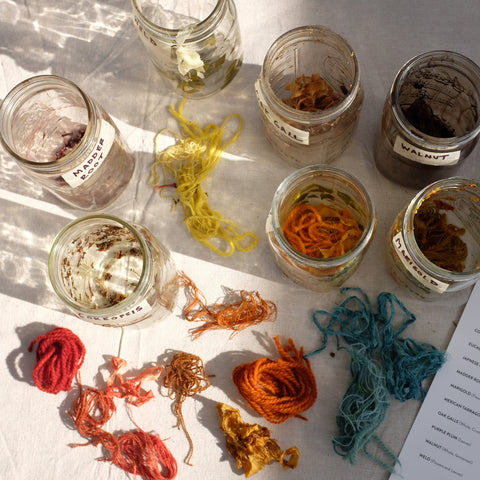Hello! Hope everyone is doing well. It has been a busy
year for me and AVFKW. We just harvested loads of dye plants for
research for our new book, coming out October 2020! More info to come.
In the mean time I will be teaching one our most popular classes at A Verb for Keeping Warm. It is a great way to kick start your interest in dyeing with plants. I hope to see you there!
xox - adrienne

Growing, Gathering, and Dyeing with Plants: Sunday, September 23rd 2018
Instructor: Adrienne Rodriguez
Explore which types of plants you can grow and gather locally that can be used in the natural dyeing process. Now is your chance to become part of an ancient tradition!
This class will prepare you for natural dyeing on four different protein (animal) fibers.
In this class, you will learn:
- How to create a dye garden, what plants to grow and how many
- How to use whole plants to create a wide variety of color
- How to harvest, forage and store plants for dyeing
- Yarn and fiber preparation which will include helpful tips for a successful end product with emphasis on colorfastness
- Mordanting with alum for protein fibers (these are fibers that come from animals) to achieve colorfast results
- Extraction of color from plants for dyeing
- Techniques for dyeing yarn samples
- Resources for continued learning
Leave class with a color card representing 10 locally sourced plant dyes on 4 different fiber types to amount to 40 samples of colorful naturally dyed yarn samples!
No experience required! Kids welcome (aged 9+ years old)
Materials included: yarn samples, color card, various locally sourced dye plants
Optional Materials to bring: rubber gloves and apron
NOTE: Class is held on our outside patio. Please dress for comfort, crafting, and weather conditions, bring sunscreen!
1 session / 3.5 hours
Cost: $125 with 24 hour advance reservation / $135 walk-in
Class Size: 15 students max.
Date: Sunday, September 23rd
Time: 1:00 pm - 4:30 pm
CLICK HERE TO SIGN UP!
Adrienne works at AVFKW as a dye technician, maintains the AVFKW dye garden, and has helped build the store from the very beginning. She is the daughter of horticulturist and the granddaughter of a farmer. With the encouragement of her mother and father she planted her first garden at the age of 8 years old. Adrienne is also an avid mushroom hunter and dyer. Taking care of the Verb dye garden and planning what to plant each year is one of Adrienne’s favorite parts of her job, she can’t wait to share the garden and her tips and tricks with you!
In the mean time I will be teaching one our most popular classes at A Verb for Keeping Warm. It is a great way to kick start your interest in dyeing with plants. I hope to see you there!
xox - adrienne

Growing, Gathering, and Dyeing with Plants: Sunday, September 23rd 2018
Instructor: Adrienne Rodriguez
Explore which types of plants you can grow and gather locally that can be used in the natural dyeing process. Now is your chance to become part of an ancient tradition!
This class will prepare you for natural dyeing on four different protein (animal) fibers.
In this class, you will learn:
- How to create a dye garden, what plants to grow and how many
- How to use whole plants to create a wide variety of color
- How to harvest, forage and store plants for dyeing
- Yarn and fiber preparation which will include helpful tips for a successful end product with emphasis on colorfastness
- Mordanting with alum for protein fibers (these are fibers that come from animals) to achieve colorfast results
- Extraction of color from plants for dyeing
- Techniques for dyeing yarn samples
- Resources for continued learning
Leave class with a color card representing 10 locally sourced plant dyes on 4 different fiber types to amount to 40 samples of colorful naturally dyed yarn samples!
No experience required! Kids welcome (aged 9+ years old)
Materials included: yarn samples, color card, various locally sourced dye plants
Optional Materials to bring: rubber gloves and apron
NOTE: Class is held on our outside patio. Please dress for comfort, crafting, and weather conditions, bring sunscreen!
1 session / 3.5 hours
Cost: $125 with 24 hour advance reservation / $135 walk-in
Class Size: 15 students max.
Date: Sunday, September 23rd
Time: 1:00 pm - 4:30 pm
CLICK HERE TO SIGN UP!
Adrienne works at AVFKW as a dye technician, maintains the AVFKW dye garden, and has helped build the store from the very beginning. She is the daughter of horticulturist and the granddaughter of a farmer. With the encouragement of her mother and father she planted her first garden at the age of 8 years old. Adrienne is also an avid mushroom hunter and dyer. Taking care of the Verb dye garden and planning what to plant each year is one of Adrienne’s favorite parts of her job, she can’t wait to share the garden and her tips and tricks with you!











